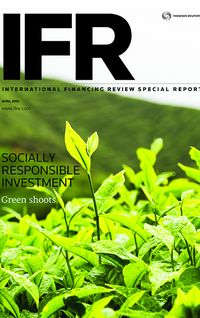Supranationals have taken to Green bonds like ducks to water. Now the market for sustainably responsible investing needs corporates to stand up and be counted.
It is a familiar lament. A new debt market asset class is launched with much fanfare. A scattering of issuers – the usual suspects, led by supranationals and agencies – leap into the fray, grabbing headlines with a few chunky sales. Then everyone stands back and waits for the private sector to catch up.
This is where socially responsible investing (SRI) finds itself. A market that sprawls, taking in everything from the need to fund social housing and youth unemployment, to worthy green-related projects, is still straining to get out of second gear.
Sales of SRI related bonds are most definitely on the up. In the 12 months to end-March 2016, 104 Green bonds were packaged and sold worldwide, raising US$45.2bn, according to data from Thomson Reuters. Over the previous 12 months, US$26.6bn was raised globally via the sale of 69 Green bonds.
“Issuance in the first quarter of 2016 surpassed total issuance in the full year in 2013, so the market is moving along very nicely,” said Robert Scharfe, chief executive officer of the Luxembourg Stock Exchange (LSE), which in February listed its 100th Green bond, a €250m sale of medium-term notes by the European Investment Bank, due 2026.
On April 5, the EIB raised US$1.5bn by pricing the largest ever 10-year Green bond, which pays a fixed semi-annual coupon of 2.125%.
Lee Cumbes, head of public sector DCM, EMEA, at Barclays, which co-underwrote the EIB’s April sale with Bank of America Merrill Lynch and JPMorgan, said the “green label certainly helped” attract investors. “In fact, it performed spectacularly well. It was quoted at 33bp over swaps a week after the deal was printed, which was around 10bp tighter than secondary market prices for an [existing] EIB non-Green bond a year shorter on the curve.”
Other supranationals and agencies to issue Green or Climate-Awareness bonds in recent years include the World Bank, the European Bank for Reconstruction and Development, and German government-owned development bank KfW.
Rumours abound that the New Development Bank, co-owned by the five ‘BRICS’ nations, will be a wholly sustainable multi-lateral when it launches, raising capital via Green bonds, which it will disburse solely to environmentally sound projects.
“Supranationals,” said Philip Brown, head of public sector origination, EMEA, at Citigroup, “clearly have played and continue to play a very important role in the market’s development.”
Marie-Anne Allier, head of euro fixed income at Amundi, which manages €950bn in assets, said that going forward, “SSAs should remain the largest players for this asset class”.
Yet is this healthy? Even multi-laterals recognise that they cannot support the asset class forever.
“It’s clear that even large supranationals can only finance a small share of the market over the long term,” said Thiam Ng, principal economist at the Asian Development Bank. “So, it’s vital that we see greater private sector participation from issuers and investors.”
Said Charles Smith, associate director and senior funding officer at the EBRD, where he oversees the development bank’s Green bond programme: “I very much hope that the supranational share of market will fall over time. The market needs to be much more about projects funded by private sector corporates and financial institutions.”
Corporate growth required
There has been some positive movement in and from the private sector. In February 2016, Apple priced a US$1.5bn seven-year bond yielding 2.85% as part of a US$12bn offering, marking the first sale of green paper by a major technology firm. In April, Dutch dairy cooperative FrieslandCampina priced a €300m green Schuldschein aimed at financing the reduction of the firm’s global environmental footprint. The same week, Iberdrola sold €1bn worth of Green bonds with a coupon of 1.125% – the lowest ever achieved by the Spanish energy group through the sale of 10-year paper – to refinance its onshore wind parks in the UK and Iberia. In April, Standard & Poor’s tipped global corporate green bond issuance to total US$28bn in 2016, up from $9.6bn in 2015.
But the onus is on corporates to do far more. Issuance by private and public sector firms comprised just 28.2% of all SRI-related sales in 2015, according to Thomson Reuters. Commercial lenders, by contrast, made up 30.4% of all issuance, led by Green bond sales from the likes of Agricultural Bank of China, Bank of America Merrill Lynch and Dutch lenders ING and ABN AMRO. (By contrast, supranationals and agencies accounted for 41.8% of all SRI-related debt issuance in 2015).
To many, the greatest hurdle for corporates is the prickly issue of determining, once a bond has been priced and capital has been raised, what constitutes a ‘green’ investment. It is perhaps unsurprising that the vast majority of SRI-related corporate debt issuance has emanated from the power sector, where green projects – wind farms, solar panels, scrubbers installed in coal-fired power plants – can be quickly and easily identified.
But for every Iberdrola or Apple, there are hundreds of other corporates either left cold by the asset class or bewildered by the challenge of determining how to put fresh green-tinted capital to work.
“For many corporates outside the renewable energy sector, it can be challenging to identify a large enough pool of eligible assets around which to build a Green bond framework,” said Citigroup’s Brown, who also sits on the bank’s global Green bond committee.
Other obstacles litter the mind of potential private sector issuers. In regulatory terms, the market remains a work in progress. The latest iteration of the International Capital Markets Association’s Green Bond Principles, published in 2015, are “guidelines” rather than watertight rules, designed, in ICMA’s words, to “promote integrity in the development of this fast growing market by clarifying the approach for issuance of a Green bond”. But no set of rules yet defines precisely what is and what is not a green project.
“The key thing everyone asks is: ‘What do we need to do to ensure this is a Green bond?’,” said Jamie Durham, debt capital markets partner at Allen & Overy in London. “And the answer that comes back isn’t always clear or uniform, which perhaps leaves some issuers and investors not entirely convinced about the product.”
Then there is the added expense of issuing a socially or environmentally responsible bond. More paperwork means higher costs, a problem that no company or institution has, as yet, managed to resolve. “Naturally, issuers will ask if there is a pricing benefit for them, given that they have to carry out a considerable amount of paperwork,” said Barclays’ Cumbes. “There is a question of whether investors will offer support by sharing the costs.” The ADB’s Ng said: “Corporates and financial institutions and sovereigns may not feel that the extra cost of issuing a Green bond is necessary at the current time.”
Time-consuming
Finally, there is a more abstract expense: that of time. Extra paperwork is one thing. But issuers, particularly listed corporates and lenders, are faced not just with delineating green from non-green costs, but also the need to prove to shareholders how and where the money was used.
To Citigroup’s Brown, this creates a quandary. “ We need to be careful not to scare issuers away with fears that the annual impact reporting will be an expensive and time-consuming burden to a resource-stretched corporate treasury,” he said. “On the other hand, investors are asking for greater clarity. So, there is this creative tension at work.”
This raft of factors explains why corporates in particular have been reticent about replicating maiden Green bond sales.
“There has been a lot of interest but not a consistent flow of repeat issuance yet,” said Allen & Overy’s Durham.
A notable example here is Unilever. The Anglo-Dutch food processor, a long-standing proponent of corporate social responsibility, launched its maiden Green bond in March 2014, raising £250m, but has not been back to this corner of the market since. (In fact, that bond still marks the only corporate sale of sterling-denominated green paper).
Few doubt this is an asset class with a bright future. Last year’s United Nations Climate Change Conference, or COP 21, will act as a natural accelerant, tacitly pushing issuers to sell Green bonds, and for investors all stripes to buy them.
“There are huge amounts of capital out there, managed by the big insurers and pension firms that are keen to invest in sustainable instruments,” said Luxembourg Stock Exchange CEO Scharfe. Citigroup’s Brown said ‘traditional’ and ‘green’ bond investors are becoming “increasingly indistinguishable” from one another, as SRI goes mainstream.
But there remains much still to do, and far still to go. Scharfe said: “Even if you are talking about billions of dollars of Green bond sales each year, it’s a drop of water in a pond when compared to total global bond issuance.”
No sovereign, moreover, has yet to directly issue a Green bond. Doing so would, said Allen & Overy’s Durham, “send out a powerful message” to investors and other nation states. But the maiden voyage may be a while off yet.
“I can’t see sovereigns issuing a Green bond,” said the ADB’s Ng, adding that it would be “hard [for them] to structure a deal”. Barclays’ Cumbes believes that while “there are definitely deals to be done”, the challenge will be “determining how to ring-fence funding, to ensure that green funding is diverted into strict green assets and investments”.
And more needs to be done to transform SRI investing into a truly global asset class. European institutions still dominate issuance, making up 66.3% of all global SRI-related bond sales in 2015, according to Thomson Reuters, with the Americas comprising 21.4% and Asia 9%.
“Corporate America hasn’t yet got fully engaged” with the market, said Citigroup’s Brown. “Going forward, for the world to achieve its climate goals, most of the action will have to come out of emerging markets.”
To see the digital version of this special report, please click here
To purchase printed copies or a PDF of this report, please email gloria.balbastro@thomsonreuters.com



